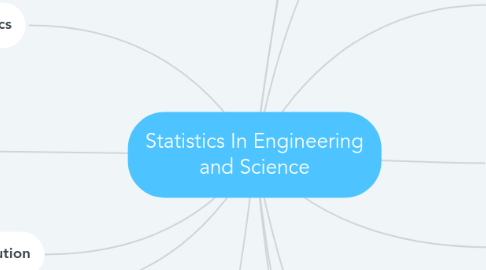
1. Sample
1.1. Representative group of the population
1.1.1. Sampling techniques
1.1.1.1. Convenience sample
1.1.1.1.1. Fast and cheap
1.1.1.1.2. Not necessarily representative
1.1.1.2. Judgmental sampling
1.1.1.2.1. Based on experience
1.1.1.2.2. Difficult to relate to population
1.1.1.3. Simple random sample
1.1.1.3.1. Sample of size n obtained from the population or process
1.1.1.3.2. Stringent requirements
1.1.1.3.3. Allows replacement
1.1.1.4. Systematic random samples
1.1.1.4.1. Sampling the kth unit
1.1.1.5. Stratified random samples
1.1.1.5.1. Subdivide heterogeneous population in groups
1.1.1.6. Cluster sampling
1.1.1.6.1. Subdivide population in clusters
1.2. Serves to make inferences about population
2. Parameters
2.1. Population values that summarizes its observations
2.2. Constant
2.3. Greek letters
2.4. Usually unknown
3. Distribution
3.1. Possible values of a variable and occurrence frequency
3.2. Example
3.2.1. Normal distribution
3.2.1.1. Parameters
4. Statistics
4.1. Sample values to estimate parameters
4.2. Random
4.3. Latin letters
5. New node
5.1. Histograms
5.2. Frequency distribution
5.3. Relative-frequency histogram
6. Outcome
7. Defined
8. Population
8.1. All possible items with common characteristics under
8.1.1. Experimental conditions
8.1.2. Observational conditions
8.1.3. Statistical analysis
8.1.3.1. Infer relationships between
8.1.3.1.1. Design factor
8.2. Fixed
9. Statistic
9.1. Problem solving with variability
9.1.1. Studies
9.1.1.1. Experimental
9.1.1.1.1. Control variables
9.1.1.2. Observational
10. Statistics in experimentation
10.1. Identify and measure
10.1.1. Sources of variation
10.1.1.1. Draw valid inferences
10.2. Statistical design and analysis
10.2.1. Project planning
10.2.1.1. Include statistical considerations
10.2.2. Experimental design
10.2.2.1. Control variation from known sources
10.2.2.1.1. Uncontrollable variation
11. Process
11.1. Repeatable series of actions resulting in
11.2. Changing
12. Variable
12.1. Characteristic on which information is retrieved
12.1.1. Types
12.1.1.1. Response
12.1.1.2. Factors
12.1.1.2.1. Can affect response variables
12.1.1.2.2. Controllable
13. Observation in experiments
13.1. Information
13.2. Actual value of variables
14. Random
14.1. Statistical
14.1.1. Approximate physical systems
14.1.2. Derived from data
14.2. Mathematical
14.2.1. Represent relationships among variables
14.2.2. Derived from theory
14.2.3. Don't take errors into account

